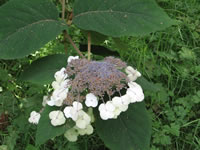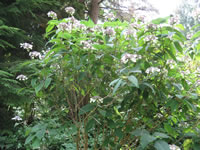How to Grow and Care for a Rough-leaf Hydrangea
Hydrangea aspera 'Robusta'
         
Hydrangea aspera is less known species of Hydrangea that is native to most of southern and eastern Asia.
In cultivation, they will grow 10 to 12 feet tall with an 8-10 foot spread.
This deciduous shrub has large (up to 10" long x 4" wide) serrated edged leaves
that are greyish-green with a fuzzy texture on the top, and light green below.
In the summer and early fall, they produce large, 10"-12", flattened flowerheads
that resemble those of the Lacecap Hydrangea.
The flowerheads have tiny purplish-blue flowers in the center, and larger,
star shaped white flowers around the perimeter that fade to pale pink with age.
|
Growing Requirements for Rough-leaf Hydrangeas
Hydrangea aspera are hardy in USDA zones 7-10.
In nature, Rough-leaf Hydrangeas are woodland plants.
They will grow best in partial or dappled shade, but can tolerate some full sun in cooler climates.
They are one of the few Hydrangea species whose flower color is not affected by the pH of the soil. They should be planted in a fertile, light, moisture retaining, slightly acidic soil that has been supplemented with lots of compost and peat moss at planting time.
They will not tolerate compacted or clay soils.
In ancient Greek, hydrangea means "water tub".
Hydrangeas need an abundance of water, keeping the soil evenly moist,
especially during their first year of growth in the garden.
Feed monthly during the growing season with a all-purpose fertilizer, following label directions.
Spent Hydrangea flowers should be removed as soon as possible to allow the plant to direct
it's strength to growing and producing new buds, rather than forming seeds. |
 |
|
Pruning Hydrangea asperas
Hydrangea aspera blooms on old wood so any needed pruning should be done immediately after blooming.
Remove all dead stems and branches on your Hydrangea regularly.
Overgrown plants can be cut back hard in mid summer without affecting the next years blooms.
Propagating New Hydrangea Aspera Plants
Rough-leaf Hydrangea plants can be propagated with softwood cuttings
taken early in the summer.
Using a sharp clean knife, strip the lower half of the leaves from a healthy, 6"-8" cutting and cut it at a slight angle, just below a node.
Dip about 3/4 inch of the cut end into a rooting hormone such as Roottone® or Hormonex®, and insert the cutting about one inch deep into sterile moist sand, vermiculite or sphagnum moss.
Create a mini-greenhouse over the container with poly film over a wire frame and place it in a bright spot (NOT full sun!) until the roots form.
After the cutting has rooted it should be planted in a mix of loam and peat moss, until it can be moved to the garden, after all danger of frost has passed in the spring.
Hydrangea cuttings can also be rooted in a glass of clean water.
Change the water regularly, or your cutting will rot! |
|
Rough-leaf Hydrangea
Hydrangea aspera
 |
 |
|
|
|
|
Search The Garden Helper:



